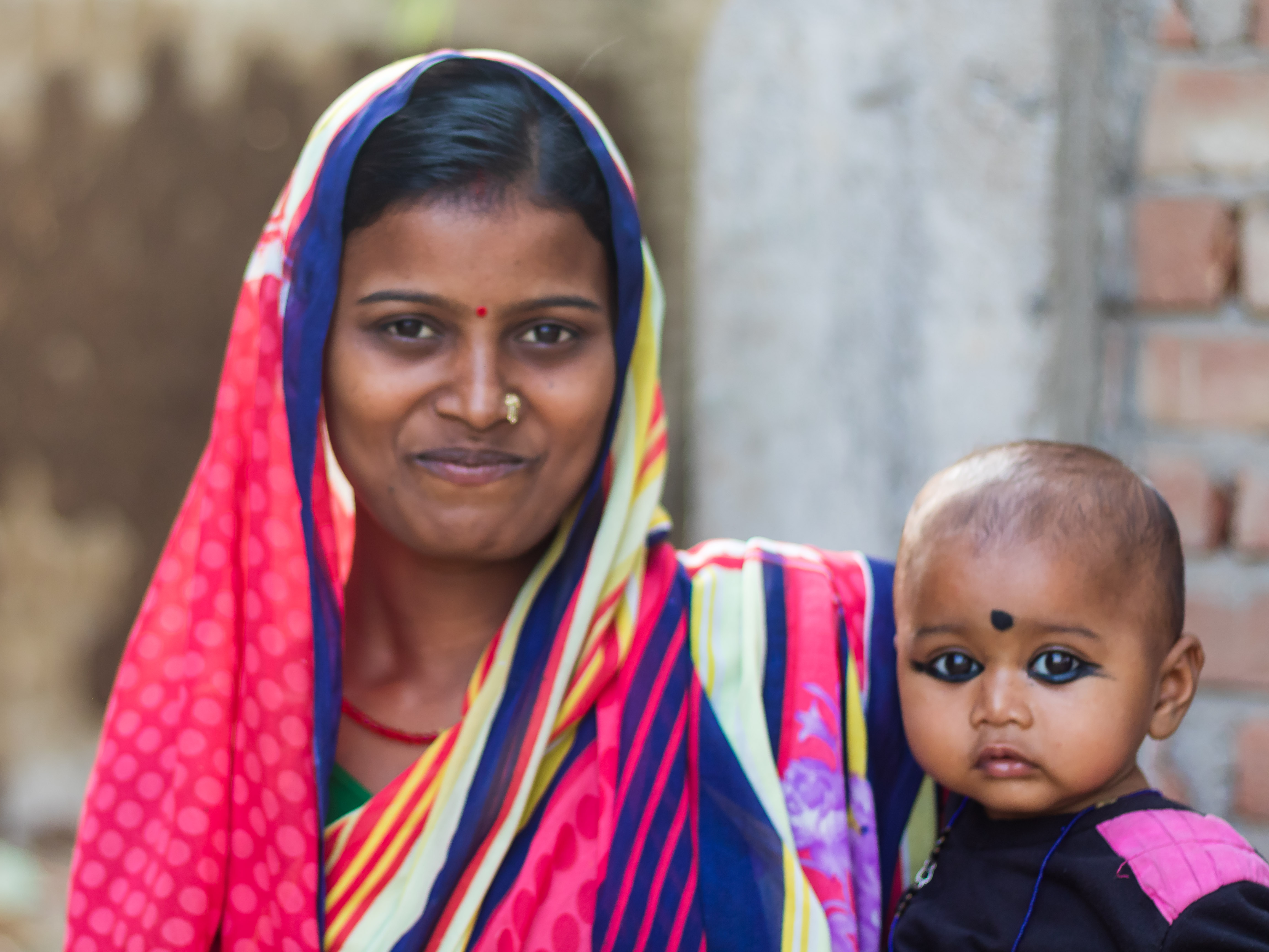Background / Program Overview
Providing targeted education and support to women in the postnatal period through combining two care innovations (group care and mobile health) through a mobile social support intervention holds great potential to improve postnatal recovery, neonatal care practices, nutritional status, knowledge and care-seeking, and general health - positively impacting maternal and child health overall. Thus, the objective of this study is to develop and pilot test a targeted interactive education and support intervention for postnatal Indian women, named Maa Shishu Swasthya Sahayak Samooh (maternal and child health support group: MeSSSSage). With the goal of optimizing the feasibility and acceptability of our final intervention, we implement a two-phase developmental process to pilot test and refine the intervention functions, processes, and delivery platform. The initial intervention, MeSSSSage prototype was developed by a team of Indian and American maternal health clinicians, researchers, and human-centered design experts based on the interdisciplinary literature, prior experience, and local and international care guidelines. MeSSSSage was designed to overcome prevalent barriers to postnatal maternal and neonatal health care through delivering culturally-tailored educational programming delivered via a provider-moderated group approach to increase women’s health-related communication with providers, refer women in a timely and appropriate manner, and connect them with a virtual social support group of other new mothers.
Building on the COM-B framework the MeSSSSage intervention seeks to impact health behaviors through the following mechanisms: 1) our mobile approach allows woman to participate in the intervention from her home to reduce the impact of sociodemographic characteristics, sociocultural factors, geography, and household responsibilities, increasing physical and social opportunity; 2) the educational content is designed to directly increase knowledge of important maternal and child health-promoting behaviors, increasing psychological capability and reflective motivation; and 3) the social support component is designed to increase reflective and automatic motivation. We hypothesize that providing targeted interactive education and support to women in the postnatal period through a mobile social network will improve their knowledge of health-promoting behaviors and their parental self-efficacy and empowerment. By appropriately identifying infant and maternal danger signs and timely care-seeking for routine and emergency visits (including referrals), we seek to reduce both infant and maternal mortality and morbidity. Furthermore, mHealth group support could help encourage and sustain exclusive breastfeeding and improve uptake of postnatal family planning and childhood vaccination, which positively affect maternal and child health in both the short and long term.
Design
The pilot intervention was delivered over a 6-week period (December 2020 through January 2021) and incorporated a weekly group call planned to last approximately 30-40 minutes. Calls were scheduled at a consistent time each week, with reminders sent to participants the day beforehand. These calls were moderated by two members of the research team: a general moderator to handle group dynamics, an obstetrician/gynecologist, and a pediatrician. To determine the best structure and understand how to optimize engagement, we varied three delivery approaches to understand women’s reception of delivery of intervention content, participation in group discussion, and format of an additional text-based chat platform. Maternal and newborn educational content was organized according to anticipated information needs in by postpartum week. Maternal content covered included danger signs, postpartum self-care and hygiene, breastfeeding, diet and nutrition, mental health, emotional support, family planning, and general health. Newborn content included danger signs, temperature regulation, infant care, massage, and developmental milestones.
Intervention feasibility and acceptability were assessed through brief weekly individual check-in calls among all participants (n=29), weekly moderator reports, structured endline interviews among a subset of intervention participants (n=15), and backend data. At enrollment, data were collected from participants on age, parity, village, contact number, mobile phone ownership (none, individually owned, shared with another household member), mobile phone type (smart versus feature phone), and willingness to accept a mobile phone.
Impact
We successfully developed a prototype intervention and piloted it with 4 groups of women (with around10 women per group) for 6 weeks. Our key findings from our mixed-methods evaluation including weekly follow up quantitative phone surveys, in-depth interviews, back end data, and moderator reports, are as follows:
- Satisfaction: Overwhelmingly, women liked the intervention, were highly satisfied, and felt that it provided them valuable information. The main barriers included access to phones and household responsibilities. While some women had their own phone, many were reliant on their husband's phone, and thus could only join calls when he was home and willing to let them use his phone.
- Solution: We will have two different versions of the intervention, one for smart and one for feature phones, and thus anticipate that most women will be able to participate with their own phones. Women who have neither type of their own will be provided a feature phone.
- Provider related: Women trusted the providers were comfortable on the calls, however, some women noted that they would prefer an all-female moderator team. Women expressed a preference for physicians or highly trained medical personnel to be on the calls, which happened in this Phase.
- Solution: Given a desire to scale up this intervention eventually, in Phase 2 we will have Auxiliary Nurse Midwives lead the calls, with a social scientist member of our team. This is responsive to women’s desires since we had initially planned to use community health workers, but also will be more scalable than the MDs that were used in this pilot phase.
- Involvement of other household members: Some husbands joined the calls, and while they were active and engaged participants, which in some ways added richness to the discussions, other women in follow-up calls expressed discomfort with men on the calls. Relatedly, some respondents wanted to engage other household members or record the calls in order to provide the information to other household members. However, there were similar privacy concerns among other respondents.
- Solution: We will encourage households and husbands to allow women to participate on their own. While we feel it will put women at risk and is not feasible to prohibit other household members to participate, we hope that by highlighting that this is a call for women about women’s issues that at least husbands will not participate. Additionally, in response to this, we have submitted an R21 for a new pilot to expand the intervention specifically to meet the needs of husbands, and to pilot that intervention, compared to all-women groups.
- Privacy: There was about an even split between respondents that did not mind being called by name and respondents who preferred not to be. Respondents mostly did not like being called upon and felt that they could raise any questions that they wanted on their own.
- Solution: When the groups are formed a decision will be made based on the comfort of women in each group; this may shift over time as women become more at ease.
- Group Dynamics: It was challenging to build group interactions and a supportive environment amongst group members. Moderators felt that having the groups start in pregnancy would allow women to get to know each other better before their babies were born (since women have more time in pregnancy than postpartum). Moderators also felt that bigger groups might help this.
- Solution: The Phase 2 study will begin recruiting around 32 weeks of pregnancy and hold two groups pre-delivery. Additionally, we will incorporate more structured activities for moderators to lead the respondents through in the calls that will help build trust and interaction. Groups will also have around 20 participants.
- Length and frequency of calls: Women generally wanted the calls to be one or two times a week (the pilot was 1 time a week), but thought they should be of shorter duration (the pilot calls were around 30 minutes).
- Solution: In Phase 2 we will have calls 2 times a week for the first 6 weeks, and then once a week for the remaining 6 months. We will have calls be around 15-20 minutes.
- WhatsApp groups: Women liked getting information on the WhatsApp group and did use that platform to ask the moderators questions in between weekly calls.
- Solution: We will continue having WhatsApp groups and offer them to all groups at all times.
- Technology/network related: There were some network challenges leading to dropped calls and poor audio.
- Solution: We have thus changed the system through which calls will be sent out to women and have tested it within the team thoroughly and found it much better.
Lessons Learned
Important gender considerations for mHealth interventions targeting women in South Asian countries:
- Phone ownership: A majority of women individually own a phone, which is almost always a smartphone. In some cases, women may own a feature phone but have access to a household smartphone. However, even when women endorse having their own phone, they may still have to share it with others (sister-in-law, mother-in-law, etc.)
- Mobile use patterns:
- Phone non-owners may have extremely limited access to phone
- Almost all phone owners use their phones for voice calls (91%) and WhatsApp (76%). Only about 1/5 use it for the internet or for videos each, and less than 10% use SMS/texting
- Among non-owners, marital family attitudes toward woman’s phone ownership, study phone acceptance When women who did not have their own phone were offered a study phone for them to use to participate in the mHealth intervention, some women readily accepted and were supported in doing so by their families, while others expressed this would not be acceptable to their families.
- Husband’s ownership of phone may preclude women’s access to a phone during the day In our study, this had implications for women’s ability to attend weekly calls scheduled during working hours. (possible control dynamics underlined)
- Non-husband phone ownership or phone sharing was common and created a barrier
- Household responsibilities create barriers to women’s phone access during the day Household responsibilities including caring for the newborn in our population of postpartum mothers were commonly cited as a barrier to participation in our weekly mHealth calls.
- There may be a non-negligible prevalence of illiteracy among women, restricting the scope of phone use
- Privacy concerns; public vs. Private domains: women had concerns about the privacy of sharing information, as did husbands.
Implications for Future Work
Next steps: Pilot test of optimized intervention, assessment of feasibility and acceptability, and preliminary effectiveness on maternal and infant health outcomes.
- Based on the findings from Aim 1, we have developed a new mHealth platform to be tested in our next phase (Phase 2). This platform has two different versions, one for women with smartphones and one for women with feature phones.
- We have also expanded the educational content to cover topics of importance from birth to 6 months postpartum and be reflective of findings from Phase 1 about additional content desired by women.




